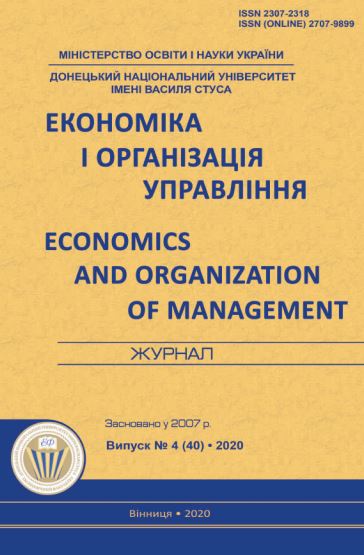Цифрові валюти у світовій фінансовій системі: переваги, недолікі, ризики, регулювання
DOI:
https://doi.org/10.31558/2307-2318.2020.4.3Ключові слова:
криптовалюта; цифрова валюта; світова фінансова система; Blockchain; електронні грошіАнотація
У роботі аналізуються роль цифрових валют у світовій фінансовій системі, особливості їхнього використання. У роботі приділяється увагу характеристиці історичним передумовам появи електронних платежів, та, як наслідок, цифрових валют. У роботі аналізуються особливості появи та функціювання основних світових криптовалют – Bitcoin, Ripple та Ethereum. До переваг криптовалют автори дослідження відносять необмежені можливості для транзакції, відсутність кордонів, швидкість транзакції. Серед недоліків криптовалют можна виділити відсутність належного рівню знань, що призводить до поширення шахрайства. У роботі наводиться обсяг та частка обсягу торгівлі біткойнами на різних ринках протягом періоду з січня 2013 року по січень 2018 року. Отримані результати дослідження дають можливість зробити висновок про те, що сучасний ринок криптовалют, попри те, що еволюція електронних грошей перебуває на початковій фазі, і готівка є все ще найбільш важливою формою оплати роздрібних операцій, є висококонкурентним та фрагментованим.
Посилання
Boshkov T. Blockchain and Digital Currency in the World of Finance. – URL: https://www.researchgate.net/publication/330948636_Blockchain_and_Digital_Currency_in_the_World_of_Finance
Bounie D, Abel F. Les dйterminants de la dйtention et de l’usage des instruments de paiement: éléments théoriques et empiriques. Revue d’Economie Financière. 2006;83:159-173
European Central Bank. The Blue Book. Bucharest: European Central Bank; 2005
David P. Positive feedbacks and research productivity in science: Reopening another black box. In: Grandstrand O, editor. Economics of Technology. London: Elsevier Science; 1994. pp. 65-89
Menger C. On the origin of money. Economic Journal. 1892;2(83):239-255
von Hayek F. Denationalisation of Money: An Analysis of the Theory and Practice of Concurrent Currencies. Londres: Institute of Economic Affairs; 1976
Schmitz SW. The institutional character of electronic money schemes: Redeemability and the unit of account. In: Latzer M, Schmitz SW, editors. Carl Menger and the Evolution of Payment Systems: From Barter to Electronic Money. Cheltenham, UK and Northampton, MA: Edward Elgar; 2001
Goodhart CAE, Krueger M. The impact of technology on cash usage. The Magazine of De La Rue. 2001;(4):9-11 Blockchain and Digital Currency in the World of Finance http://dx.doi.org/10.5772/intechopen.
White LH. The technology revolution and monetary evolution. In: Dorn JA, editor. The Future of Money in the Information Age. Washington, D.C.: CATO Institute; 1996
Chakravorti S, Victor L. Payment instrument choice: The case of prepaid cards. Economic Perspectives. 2006;2Q:29-44
Gerald S. The Electronic Purse: An Overview of Recent Development and Policy Issues. Bank of Canada; 1996
BIS. Implications for Central Banks of the Development of Digital Money. Basel: Bank of International Settlements; 1996
BIS. Survey of Developments in Electronic Money and Internet and Mobile Payments. Basel: Bank of International Settlements; 2004
BIS. Statistics on Payment and Settlement Systems in Selected Countries. Basel: Bank of International Settlements; 2006
Klenow JP. Evidence on Learning and Network Externalities in the Diffusion of Home Computers. Federal Reserve Bank of Minneapolis and NBER; 2002
Centi JP. Currency competition and the monetary union. Unpublished PhD dissertation. Aix-Marseille University; 1979
Humphrey D, Kim M, Vale B. Realizing the gains from electronic payments: Costs, pricing and payment choice. Journal of Money, Credit and Banking. 2001;33(2):216-234
Krueger M. Toward a moneyless world. In: Paper Prepared for the International Atlantic Economic Conference Vienna; March 16-23, 1999
Economides N, Himmelberg C. Critical mass and network evolution in telecommunications. In: Brock G, editor. Toward a Competitive Telecommunication Industry: Selected Papers for the 1994 Telecommunications Policy Research Conference. Mahwah, NJ: Lawrence Erlbaum; 1995. pp. 47-63
Oliver PE, Marwell G, Teixeira R. A theory of the critical mass. I. Interdependence group heterogeneity, and the production of collective action. American Journal of Sociology. 1985; 522-556
Osterberg W, Thomson J. Network externalities: The Catch-22 of retail payment innovations. In: Economic Commentary. Federal Reserve Bank of Cleveland; 1998
Stavins J. Effect of consumer characteristics on the use of payment instruments. Federal Reserve Bank of Boston New England Economic Review. 2001:20-31
Katz ML, Shapiro C. Technology adoption in the presence of network externalities. Journal of Political Economy. 1986:822-841
Schmalensee R. On antitrust issues related to networks. In: Testimony Before the Federal Trade Commission, Hearings on Global Competition/High-Tech Innovation, December 1995
Economides N. Economics of networks. International Journal of Industrial Organization. 1996;14:673-700
ECB Report 2019. – URL: https://www.ecb.europa.eu/pub/annual/html/index.en.html
Digital currencies and the future of the monetary system. – Bank of International Settlements. - URL: https://www.bis.org/speeches/sp210127.pdf
Yermack D. Is Bitcoin a Real Currency? An economic appraisal. – URL: https://www.nber.org/papers/w19747
Cyn-Young Park, Shu (Grace) Tian, and Bo Zhao GLOBAL BITCOIN MARKETS AND LOCAL REGULATIONS // ADB ECONOMICS WORKING PAPER SERIES. – January, 2020. - #605. – URL: https://www.adb.org/sites/default/files/publication/559596/ewp-605-global-bitcoin-markets.pdf
Bouoiyour, Jamal, and Refk Selmi. 2015. “What Bitcoin Looks Like?” Annals of Economics and Finance 16 (2): 449–92.
Dyhrberg, Anne Haubo. 2016a. “Bitcoin, Gold and the Dollar–A GARCH Volatility Analysis.” Finance Research Letters 16: 85–92.
Bouri, Elie, Peter Molnбr, Georges Azzi, David Roubaud, and Lars Ivar Hagfors. 2017. “On the Hedge and Safe Haven Properties of Bitcoin: Is It Really More Than A Diversifier?” Finance Research Letters 20: 192–98.
Bouri, Ellie, Rangan Gupta, Aviral Kumar Tiwari, and David Roubaud. 2017. “Does Bitcoin Hedge Global Uncertainty? Evidence from Wavelet-Based Quantile-In-Quantile Regressions.” Finance Research Letters 23: 87–95.
Farrell J, Saloner G. Standardization, compatibility and innovation. RAND Journal of Economics. 1985;16:70-83
Virtual Currencies Key Definitions and Potential AML/CFT Risks: FATF Report. – 2014. - URL: https://www.fatf-gafi.org/media/fatf/documents/reports/virtual-currency-key-definitions-and-potential-aml-cft-risks.pdf

